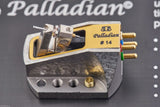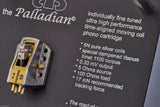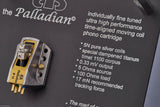Description:
Acoustical Systems The Palladian Cartridge
Acoustical Systems' tonearm Aquilar, as well as the top-of-the-range model Axiom, are characterized by the UNI-DIN geometry newly developed by Dietrich Brakemeier. The analogue specialists from Bavaria have not yet invented a new generator principle, but with The Palladian Cartridge they thoroughly demonstrate how far one can get sonically with the ingenious combination of already well-known solutions.
The Palladian is an advanced development of the Aiwon, in which Dietrich Brakemeier was primarily concerned with getting a good bit closer to the live impression of music—or, in a more prosaic way of speaking, to further improve the cartridge's dynamic capabilities and instantaneous immediacy. For this purpose, the cantilever was shortened a little, which reduced the moving mass, while the bracing wire was also modified. Incidentally, The Palladian's cantilever, as happens with all Acoustical System cartridges, is made of tempered aluminum, which in addition has been treated with C37 lacquer. According to the designer's experience, cantilevers made of harder materials such as boron, ruby, or diamond, are subject to resonances in the presence range, which among other things leads to an overexposure of noise, which appears in a more or less high amount in every recording. Aluminum therefore happens to resonate in a lower, less disturbing frequency range. In addition, in Acoustical System cartridges these intrusions are minimized by the C37 lacquer.
Each of the two coils of The Palladian comprises seven windings of very low oxygen 5N silver—and this is exactly one winding more than the Aiwon has. Although both cartridges feature each a magnet of the same strength, The Palladian comes up with a magnetic field in which the coils move that is said to be minimally stronger, the reason for this being a better focusing within this area. For me this seemed quite a contradiction, to reduce the moving mass on the one hand, and to apply one more winding of wire to the coil carrier on the other. Dietrich Brakemeier responded by saying that the two additional windings corresponded to the weight of about only one hundredth of a millimeter of the needle carrier's length, which is absolutely negligible compared to its shortening.
The hammered surface of the titanium alloy body makes every Palladian unique.
Of course, Acoustical Systems does not manufacture the generators of its cartridges themselves, but has them built by a renowned West European manufacturer. However, the stylus, as Dietrich Brakemeier notes, is not taken from the portfolio of the said manufacturer, but is purchased in Germany and then supplied to them. It was decided to use a very smoothly polished Q4 Shibata EVO profile, as it was formerly used in Quadro compatible cartridges. Although today's recordings no longer contain tones in the 40 Kilohertz range, the given ample high-frequency tracking ability does have a very positive effect on the upper frequency range of women's voices, for example.
The generators manufactured to Acoustical-Systems' specifications are then "wedded" in Bavaria with the bodies. The body is made of hammered TIMET TIMETAL® 1100, a titanium alloy titled "Ti-6Al-2.7Sn-4Zr-0.4Mo-0.45Si". The surface treatment not only changes the shape—considerably fewer parallel surfaces result thereof—but also the internal structure of the material, so that resonances can spread less strongly throughout the material compared to bodies with parallel surfaces and continuous crystal lattice parameters. The generator is fixed to the body with an epoxy-resin glue at three defined points, while Dietrich Brakemeier dampens the body/generator unit with two different polymers at four points. Naturally, the cartridge comes in a representative package, including a few accessories, such as three pairs of brass screws in different lengths, which were chosen because of their favourable sonic conductance.
Since the Acoustical Systems tonearm was still mounted on the more distant base of my LaGrange turntable, and while it certainly had to be one of the best possible matches for The Palladian, as no one was able to adjust this tonearm better than its developer, I consequently asked him to install the cartridge. Despite the Aquilar offering diversified adjustment possibilities, I fairly quickly was sure that Acoustical Systems' new top model was perfectly adjusted to my turntable. After listening to a few of Dietrich Brakemeiers' test tracks, we then switched to some of my own repertoire, not with the intention to evaluate the cartridge, but only to get some new, insightful songs the other might have. For a critical evaluation, The Palladian simply hadn't collected enough hours of operation. For burning-in the cartridge, I again used Keith Jarrett's solo albums Sun Bear Concerts and Bremen/Lausanne. And already at this point I got the impression that the Palladian was playing in a very open and spacious manner.
The body of The Palladian features two defined contact surfaces with three threads in each of them. This allows for an exact adjustment in almost every tonearm.
I like to admit that lately, because of the various new entries in my digital playback chain, I have been neglecting my record collection a bit. One evening, when I heard Zakir Hussain's great ECM recording Making Music, I was startled by what I recently had been missing. Hariprasad Chaurasias' flutes, John McLaughlin's acoustic guitar, Jan Garbarek's saxophone, and Zakir Hussain's percussion sounded as dynamic and seamless as I previously had experienced only from some audiophile recordings such as old direct-to-disc albums. Tonal colours and transients came very much close to a live performance in a club, like the Neuburger Birdland club where musicians use to play unplugged. The way the sound was detaching from the loudspeakers was so convincing that this highly realistic effect also affected the music's spatial portrayal. Acoustical Systems' cartridge-tonearm combo certainly has its share in all of this, but it is still too early to award them the merits for this magnificent performance. As already said, I haven't been listening to vinyl for quite a long time. However, in the meantime a lot has happened in my listening room. At the present the Kaiser Acoustics Kawero! Classic are substituting the LumenWhites, while some successfully applied tuning devices from Harmonix improve the room acoustics, and the splendid PS Audio BHK Signature provides the necessary power.
But before I compared The Palladian with the equally vivid and sumptuous Transrotor JR Tamino in the Thales Symplicity II tonearm to assess the Acoustical System components' proportion in the overwhelming musical experience just described, I experimented a bit with different impedance loads. The Palladian started its test round with the 85 ohms I had previously run the Lyra Etna with. Thus I interpreted the manufacturer's recommendation—they specify 100 to 200 ohms—a little bit too generous. However, this specification ranged in the upper scope of the usual empirical formula and even beyond, as the load resistance should be 10 to 20 times the generator's internal resistance value: That would resemble 50 to 100 ohms for the specified five ohms. For this purpose I used the plug-in resistors valued 40, 85, 150, and 300 ohms supplied with Einstein's balanced phono stage "The Turntable's Choice." Contrary to Acoustical Systems' recommendation, I tried to use 40 ohms instead of the previous 85 ohms, but this turned out to be a bad idea, because Dick Schory's "Buck Dance" from the album Bang, Baaroom and Harp was rendered comparatively hampered and less airy. The portrayal of depth and room height appeared some way restricted.
The bracing wire protrudes quite a bit from its duct. The coils are wound on a plastic cross.
So I tried to go with the other extreme, in this case 300 ohms, and this attempt provided results that were significantly better. A huge space opened up, the musicians literally sparkled with the joy of playing. Now performing at its best, it tonally also stepped a little bit to the bright side. Opting for half of the load impedance, the tonal colours became somewhat richer again, the endeavours of the New Perkussion Ensemble reached the same intensity as before and the acoustic image seemed exceptionally credible—albeit not quite as spectacular as with 300 ohms. Since The Palladian had been attracting me so much with the 85 ohms loading, I tried this value again. However, the sound was approaching too much the way it had been performing in a somewhat more extreme way with the loaded 40 ohms. In conjunction with The Palladian, Einstein's phono preamplifier for my taste works best with 150 ohms—of course, the ideal load impedance depends very much on the circuitry of the phono stage's input section. Needless to say, I once again checked how the now chosen load resistance affected the playback of Making Music: The immediacy of the entry of guitar and saxophone impressed a bit more, Jan Garbarek's soprano saxophone became a touch more poignant, and the spatiality appeared to be a little more airy.
The diamond stylus is acutely mounted without any visible adhesive residues.
The fact that The Palladian performs best in all well-known audio disciplines and that it demonstrates excellence in immediacy and live character should now be more than clear. But with all the records heard along the test run, a primary experience has gained ground in an initially very subliminally, but then increasingly deliberate way: Even within the wildest musical performances, or throughout fortissimo passages, or when facing brutal impulses, The Palladian unveils an integral sovereignty. You surely have experienced that particular kind of sensation that creeps up when a cartridge tracks a critical passage, yet without distortion, but the feeling sets in that something of a limit has been reached, and more consequently would endanger a stress-free playback. The Palladian doesn't raise these concerns at all. It is always in charge of the situation – and therefore you are able to enjoy even the most violent musical attacks in full intensity, yet highly relaxed. Magnificent!
After taking my decision for the final load impedance of 150 ohms, I granted The Palladian some more of my records, and a few days later subsequently awoke the long unused JR Tamino from his slumber, letting it play two album sides right away. Months ago, I had opted for the lower terminating load of 40 ohms, as this impedance supported the Tamino's full-bodied, colour-intense and physically palpable acoustic depiction. A few minutes of Zakir Hussain's fantastic album were sufficient to make clear that the analogue division of my playback system nourishes its fascination not only through Acoustical Systems' combo: The JR Tamino mounted to the Thales tonearm lets oneself delightfully indulge in iridescent sounds, while the Acoustical Systems duo lets Making Music unleash a slightly richer dose of adrenaline. Its dynamics make the live experience a touch more tangible. It remains to be seen which proportion of the sound quality can be allocated to the cartridge or to the tonearm, in both cases equipped with non-interchangeable internal wiring. However, for me there is only one conclusion to be taken out of this: As of now, I want to listen to a lot more records again, no matter which of these two tantalizing high-class cartridge systems I use.
Acoustical Systems has proved with its two tonearms that even today innovations in the analogue sector are feasible. The Palladian shows that one does not have to reinvent the wheel to play in the top league. Dietrich Brakemeier's long-standing analogue experience has allowed him to design a cartridge that works at the highest level and, in its thrilling immediacy, comes impressively close to the live experience.
SPECIFICATIONS
Acoustical Systems The Palladian
- Principle Moving Coil
- Output voltage 0.33mV at 5cm / sec
- Static needles 16-18mm / N at 18 ° C to 30 ° C
- Recommended holding force 17-18mN
- Channel equalization 0.35dB at 1kHz
- Channel separation 32dB
- Frequency response 15Hz to 32kHz ± 2dB
- Needle grinding Q4 Shibata EVO
- Internal resistance 5Ω
- Recommended terminating resistor 100-200Ω
- Mass 11.8g




